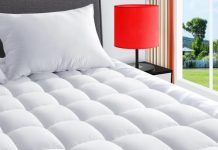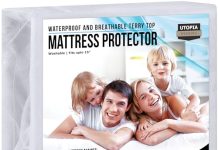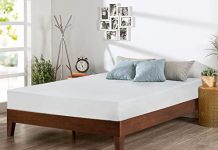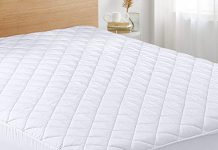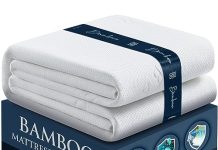If you’ve ever found yourself tossing and turning in the middle of the night, desperately searching for a way to make your mattress just a little more comfortable, then you’re in good company. Many of us have been there, trying to find the perfect solution for a restful night’s sleep. One option that often comes up in the search for a better night’s rest is the mattress topper. But with so many types to choose from, it can be overwhelming to know which one is right for you. In particular, the age-old question of foam versus feather mattress toppers often leaves people scratching their heads. So, let’s explore the key differences between these popular options and discover which one might be the secret to your best night’s sleep.
Review contents
Foam Mattress Topper
What is a foam mattress topper?
A foam mattress topper is a layer of foam that is placed on top of a mattress to provide extra comfort and support. It is designed to adjust to the contours of your body, relieving pressure points and promoting proper spine alignment while you sleep. Foam mattress toppers come in various thicknesses and materials, but the most common type is memory foam, which is known for its ability to mold to the shape of your body.
Types of foam mattress toppers
There are several types of foam mattress toppers available in the market. The most popular ones are memory foam, latex foam, and polyfoam.
- Memory foam toppers are made from viscoelastic material, which responds to body heat and pressure, allowing it to conform closely to your body’s shape. This provides excellent cushioning and pressure relief.
- Latex foam toppers, on the other hand, are made from natural or synthetic latex. They offer a more responsive and springy feel compared to memory foam, and they also have a natural cooling effect.
- Polyfoam toppers are made from polyurethane foam and are known for their affordability and durability. They provide a firmer feel compared to memory foam or latex foam.
Benefits of foam mattress toppers
Foam mattress toppers offer numerous benefits that can greatly enhance the comfort and quality of your sleep.
- Improved comfort: The soft and cushioning properties of foam toppers provide an extra layer of comfort, making your mattress feel more luxurious.
- Pressure point relief: Foam toppers are designed to distribute your body weight evenly and relieve pressure points, which can help alleviate pain in certain areas like the shoulders, hips, and back.
- Spine alignment: By contouring to your body’s shape, foam toppers can help maintain proper spine alignment, reducing the risk of waking up with aches and pains.
- Noise reduction: Foam toppers can absorb and minimize noise, making them an excellent choice if you share your bed with a partner who moves or tosses and turns during the night.
- Motion isolation: If you sleep with a partner, foam toppers can help reduce the transfer of motion, minimizing disturbances caused by their movements.
Density and firmness options
Foam mattress toppers come in a range of densities and firmness levels, allowing you to choose the one that best suits your personal preferences and needs.
- Density: Foam density refers to the weight of the foam per cubic foot. Higher density foams are generally more durable and provide better support, while lower density foams offer a softer feel.
- Firmness: Foam mattress toppers are available in various firmness levels, ranging from soft to medium to firm. Your ideal firmness level will depend on factors such as your body type, sleeping position, and personal preference.
Heat retention
One common concern with foam mattress toppers is heat retention. Some people find that foam toppers can trap heat and make them feel overly warm during the night. However, advancements in foam technology, such as open-cell construction and gel-infused foams, have addressed this issue. These features promote better airflow and heat dissipation, helping to regulate your body temperature and keep you cool throughout the night.
Motion isolation
Another advantage of foam mattress toppers is their ability to isolate motion. If you share your bed with a partner or a restless sleeper, you may experience disruptions in your sleep due to their movements. However, foam toppers can absorb and minimize the transfer of motion, allowing you to sleep undisturbed. This is particularly beneficial for light sleepers or couples who have different sleep schedules.
Durability and longevity
When investing in a foam mattress topper, it’s important to consider its durability and longevity. Foam toppers, especially those of higher density, are known for their durability and ability to maintain their shape over time. They are less prone to sagging or developing permanent indentations, ensuring that you can enjoy their benefits for an extended period. Regularly rotating the topper can also help to prolong its lifespan.
Maintenance and care
Foam mattress toppers are relatively easy to maintain and care for. Here are some tips to keep your topper in good condition:
- Regularly air out your topper by removing it from the bed and allowing it to breathe for a few hours.
- Spot clean any stains or spills using a mild detergent or cleaner specifically designed for foam products.
- Use a mattress protector or cover to protect the topper from dust, dirt, and spills. This will also help prolong its lifespan.
- Follow the manufacturer’s instructions regarding washing and drying to ensure proper care.
Price range
The price of foam mattress toppers can vary based on factors such as the type of foam, density, thickness, and brand. Generally, memory foam and latex foam toppers tend to be more expensive compared to polyfoam toppers. Prices typically range from $50 to $300, depending on the size and quality of the topper. While you may be tempted to opt for a cheaper option, it’s important to consider the quality and durability of the foam to ensure you make a wise investment in your sleep comfort.
Choosing the right foam mattress topper
When choosing a foam mattress topper, it’s essential to consider your specific needs and preferences. Here are a few factors to keep in mind:
- Desired level of firmness: Determine whether you prefer a soft, medium, or firm feel and choose a topper with appropriate firmness levels.
- Body type and weight: Consider your body type and weight distribution to ensure the topper provides adequate support and pressure relief.
- Material: Explore different foam options, such as memory foam, latex foam, or polyfoam, to find the one that suits you best in terms of comfort and responsiveness.
- Thickness: The thickness of the topper can affect its overall feel and support. Thinner toppers provide a more subtle change to the mattress, while thicker toppers offer a more pronounced cushioning effect.
- Budget: Set a budget and look for options within your price range, considering the quality and durability of the foam topper.
Feather Mattress Topper
What is a feather mattress topper?
A feather mattress topper, also known as a featherbed, is a layer of feathers and down that is placed on top of a mattress to provide added softness, cushioning, and insulation. Feather toppers are typically made from a mixture of feathers and down, with down being the softer and lighter portion obtained from the underbelly of ducks or geese. The feathers provide support and structure, while the down adds luxurious comfort.
Types of feather mattress toppers
Feather mattress toppers come in various types, primarily differing in the ratio of feathers to down and the type of feathers used. The two main types are:
- Feather toppers: These toppers are made predominantly from feathers, providing a firmer feel and more support. They are generally more affordable compared to down toppers, but they may not offer as much softness and cushioning.
- Down toppers: These toppers are made mostly from down, offering a plush and cloud-like feel. They provide excellent insulation and are known for their incredible softness and lightweight comfort. Down toppers are considered more luxurious but are typically more expensive.
Benefits of feather mattress toppers
Feather mattress toppers offer several benefits that can enhance your sleeping experience:
- Softness and cushioning: The combination of feathers and down in feather toppers creates a plush and cushioning effect, adding an extra layer of comfort to your mattress. They provide a gentle cradle for your body and can help relieve pressure points, promoting a more restful sleep.
- Breathability and temperature regulation: Feather toppers have excellent breathability, allowing for proper air circulation and heat dissipation. This helps regulate your body temperature and prevent overheating, making them ideal for all seasons.
- Lightweight and fluffy: Feather toppers are naturally lightweight and fluffy, giving your bed a luxurious and inviting appearance. They provide a soft and cozy sleeping surface and can make your bed feel like a haven of relaxation.
- Durability: Feather toppers, especially those with a higher proportion of feathers, are known for their durability. The feathers provide structure and resilience, allowing the topper to maintain its shape and support over time.
Softness and cushioning
One of the main reasons people choose feather mattress toppers is for their softness and cushioning. The combination of feathers and down creates a plush and gentle cradle for your body. When you lie down, the topper contours to your shape and provides a comfortable and cozy sleep surface. The softness and cushioning provided by feather toppers can help alleviate pressure points and provide relief for aching muscles and joints.
Breathability and temperature regulation
Feather mattress toppers are highly breathable, allowing for proper air circulation and heat dissipation. The natural ventilation properties of feathers help regulate your body temperature, preventing overheating and keeping you cool during warmer nights. The breathability of feather toppers makes them an excellent choice for year-round use, as they can help keep you warm in the winter and cool in the summer.
Allergy concerns
Feather mattress toppers may not be suitable for everyone, especially those with allergies or sensitivities to feathers or down. Feathers and down can harbor dust mites and allergens, which may trigger allergic reactions in some individuals. However, many manufacturers offer hypoallergenic options that have been treated to minimize the presence of allergens. If you have allergies, it’s essential to choose a feather topper that is specifically labeled as hypoallergenic or suitable for allergy sufferers.
Maintenance and care
Feather mattress toppers require regular maintenance and care to ensure their longevity and performance. Here are some tips to keep in mind:
- Fluff and shake the topper regularly to redistribute the feathers and maintain its loft and softness.
- Use a mattress protector or cover to protect the topper from spills, stains, and dust. This will help extend its lifespan and make cleaning easier.
- Spot clean any spills or stains immediately using a mild detergent or cleaner suitable for feather products.
- Air out the topper periodically by hanging it outside or placing it in a well-ventilated area. This will help remove any odors and keep the topper fresh.
- Follow the manufacturer’s instructions for washing and drying, if applicable. Some feather toppers may be machine washable, while others may require professional cleaning.
Price range
The price of feather mattress toppers can vary depending on the quality of the feathers, the proportion of down used, and the brand. Down toppers are generally more expensive compared to feather toppers due to the higher cost of down. Prices typically range from $100 to $500, depending on the size and quality of the topper. It’s important to consider the quality and fill power (the amount of space one ounce of down occupies) when selecting a feather topper to ensure you get the best value for your money.
Choosing the right feather mattress topper
When selecting a feather mattress topper, consider the following factors to find the one that suits your needs and preferences:
- Ratio of feathers to down: Determine whether you prefer a topper with a higher proportion of feathers for firmer support or a topper with more down for a softer and more plush feel.
- Fill power: Look for a feather topper with a higher fill power, as this indicates a greater quality and loft. Higher fill power means the feathers are larger and provide better insulation and comfort.
- Allergy concerns: If you have allergies or sensitivities to feathers, look for a topper that is labeled hypoallergenic and has been treated to minimize allergens.
- Size and thickness: Consider the size and thickness of the topper to ensure it fits your mattress properly and provides the desired level of softness and support.
- Budget: Set a budget and explore options within your price range, considering the quality, fill power, and durability of the feather topper.
Comparing foam and feather mattress toppers
Choosing between a foam and a feather mattress topper ultimately comes down to personal preference and specific needs. Here are some factors to consider when comparing the two types:
- Comfort and support: Foam toppers excel in providing targeted support and pressure point relief, while feather toppers offer a plush and cushioning feel. Consider whether you prioritize support or softness in your sleeping experience.
- Temperature regulation: Foam toppers with advanced cooling features, such as gel-infused foam or open-cell construction, may be better at regulating temperature compared to feather toppers. However, feather toppers have excellent breathability, making them suitable for year-round use.
- Allergies: If you have allergies or sensitivities to feathers, a foam topper may be a better choice. Foam toppers are hypoallergenic and do not harbor allergens like feathers can.
- Durability: Foam toppers, especially those with higher densities, are generally more durable and better at maintaining their shape over time compared to feather toppers.
- Price: Foam toppers tend to be more affordable compared to feather toppers, although high-quality foam options can be more expensive. Consider your budget and weigh the cost against the desired features and benefits.
- Sleeping position and preferences: Your sleeping position and individual preferences can also play a role in choosing the right topper. For example, side sleepers may benefit from the pressure-relieving properties of foam toppers, while back sleepers may enjoy the softness and support provided by feather toppers.
In the end, the choice between a foam and a feather mattress topper is subjective and depends on your personal preferences, comfort needs, and budget. Both types offer their unique advantages and can significantly enhance the comfort and quality of your sleep. Consider the factors discussed above and take the time to test out different options to find the perfect mattress topper that suits your sleep style and preferences.




